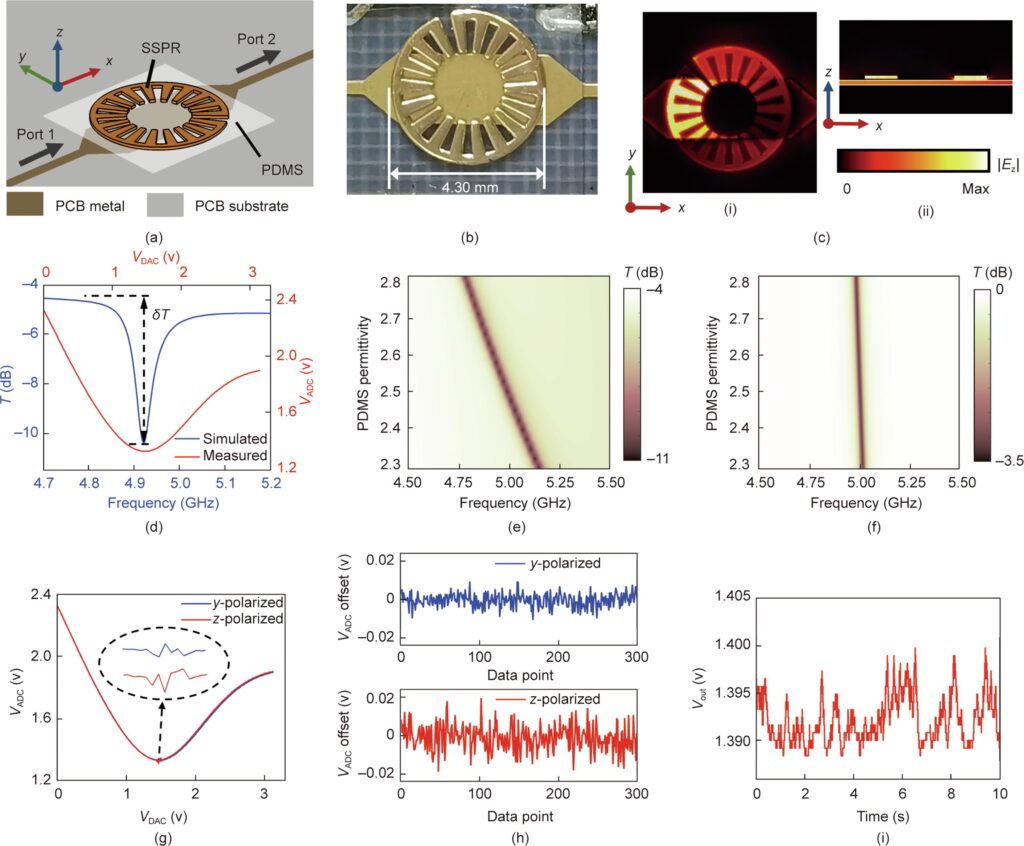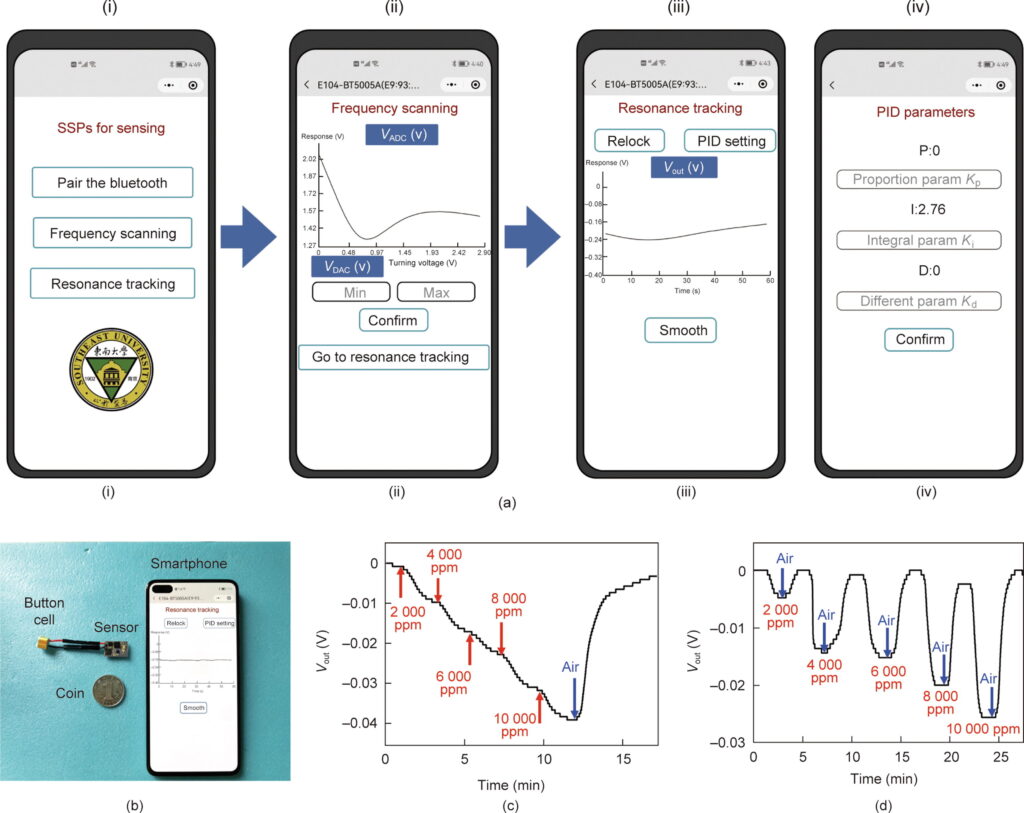Tricorder Tech: Away Team Gas Detection With A Smartphone

Editor’s note: A key aspect to understanding a new location during an Away Team Mission is understanding the local atmosphere and how it is affected by – and influences – life forms – and how it can vary over time and location. In the case of examining extremophiles in locations such as caves, wells, or other isolated locations, the atmosphere may cary considerably from what is seen on the surface. Having a system that can do in situ analysis can be vital – not only for science but also for crew safety. Using a common smartphone platform allows adaptation of this technology by a broader number of users here on Earth by virtue of using a easily obtained smartphone platform.
__________________________
Groundbreaking Ultracompact Spoof Surface Plasmon Sensing System Revolutionizes Gas Detection with Smartphone Integration
A team of researchers from Southeast University of China has developed a cutting-edge ultracompact sensing system that leverages the power of spoof surface plasmon resonance (SSPR) technology to enable adaptive and accurate gas detection using a smartphone. The research article detailing this breakthrough, titled “An Ultracompact Spoof Surface Plasmon Sensing System for Adaptive and Accurate Detection of Gas Using a Smartphone,” has been published in the prestigious journal Engineering.

Compact integrated sensing system to track resonance shift of SSPR: (a) Schematic of integrated SSP sensing system, including signal processing circuit and sensing network; (b, c) photographs of integrated sensing system: (b) top view and (c) bottom view; (d) block diagram of hardware system of integrated sensing system. The blue blocks indicate the main microwave analog circuit, and the yellow blocks indicate the digital computation and communication circuits. — Engineering
Traditional dielectric sensing methods often suffer from signal fluctuations, resulting in reduced sensitivity and accuracy. In response to the growing demand for precise gas detection in the Internet of Things (IoT) era, the research team has successfully engineered an ultracompact integrated sensing system that combines a spoof surface plasmon resonance sensor with signal detection, processing, and wireless communication.
The key innovation of this technology lies in its software-defined scheme, which allows for real-time tracking of resonance frequency shifts. By minimizing the hardware circuit, the system achieves adaptability to the target resonance, making it highly efficient and versatile. Additionally, the team designed a microwave spoof surface plasmon resonator to enhance sensitivity and resonance intensity, further improving the system’s performance.

Design and measurement of SSPR: (a) Design of SSPR and sandwiching excitation structure; (b) photograph of fabricated SSPR, attached to exciting microstrip pattern with interlayer of transparent PDMS film; (c) simulated |Ez| distributions (i) on the resonator surface and (ii) the cross-section on xz-plane; (d) simulated and on-PCB measured transmittance spectra of SSPR. (e) mapping of simulated SSPR transmittance spectra varied with relative permittivity of PDMS; (f) mapping of simulated transmittance spectra for contrast MRR. (e) and (f) share the same mapping color bar; (g) measured transmittance spectra with continuous-wave (CW) interfering radiations at 4.94 GHz in y- and z-polarizations; (h) offsets of ADC voltage at bottom of resonance dip, measured with CW interfering radiations of 25 dBm at 4.94 GHz in y- and z-polarizations; (i) noise level of resonance tracking detection measured with CW interfering radiations of 25 dBm at 4.94 GHz in z-polarization. |Ez|: amplitude of the z component of the electric field; T: transmittance; δT: resonance intensity; VADC: ADC voltage; VDAC: DAC voltage; Vout: the voltage signal output of the resonance-tracking scheme; MRR: microstrip ring resonator. — Engineering
The integrated sensing system, constructed on a printed circuit board measuring a mere 1.8 cm × 1.2 cm, seamlessly connects to a smartphone via Bluetooth. It operates in both frequency scanning mode and resonance tracking mode, achieving an impressive signal-to-noise ratio of 69 dB in acetone vapor sensing. This breakthrough offers an ultracompact, accurate, adaptive, sensitive, and wireless solution for resonant sensors in the IoT.
The significance of this study lies in: The ultracompact sensing system represents a major advancement in gas detection technology. By integrating spoof surface plasmon resonance with smartphone connectivity, researchers have developed a solution that is not only highly sensitive and accurate but also adaptable to various resonant frequencies. This breakthrough has wide-ranging applications in the IoT and opens up new possibilities for smart homes and beyond.
The research article provides comprehensive insights into the system’s architecture, the design and analysis of the SSPR sensor, the intelligent resonance tracking scheme, and a successful demonstration of acetone vapor sensing. The team achieved exceptional results, including a signal-to-noise ratio of 69 dB, a data rate of approximately 2272 measuring points per second, and excellent electromagnetic compatibility performance.

Acetone vapor-sensing experiments using the integrated system: (a) Smartphone user interface for (i) function menu, (ii) frequency scanning, (iii) resonance tracking, and (iv) user-defined PID parameter setting; (b) Photograph of sensor working with smartphone; the size of the sensing system is compared with a coin with a diameter of 2.5 cm; (c) Response of sensing system to increasing concentrations of acetone vapor; (d) Response of sensing system to acetone vapor pulses with different concentrations. The concentrations in red refer to acetone vapor pulses. The “Air” texts with blue arrows refer to the moment when air pulses are injected. For acetone vapor concentration, 1 ppm ≈ 0.386 mg·m−3. — Engineering
The implications of this research extend far beyond gas detection. The ultracompact and intelligent nature of the proposed sensing system paves the way for its use in various resonant sensors, including those based on mechanical and acoustic principles. The team envisions applications in smart homes and the IoT, where the compactness and accuracy of the system will drive innovation and improve quality of life.
This groundbreaking research marks a significant milestone in the field of gas detection and resonant sensor technology. The team’s innovative approach, combining ultracompact design, adaptive detection, and wireless integration with smartphones, promises to revolutionize the future of gas sensing in the IoT era.
The paper “An Ultracompact Spoof Surface Plasmon Sensing System for Adaptive and Accurate Detection of Gas Using a Smartphone” has been published in Engineering, authored by Xuanru Zhang, Jia Wen Zhu, Tie Jun Cui. Full text of the open access paper: https://doi.org/10.1016/j.eng.2023.05.013.
Astrobiology








